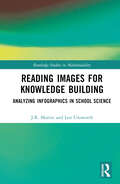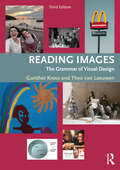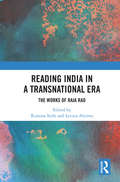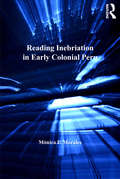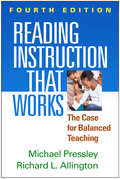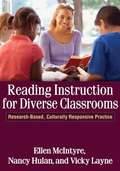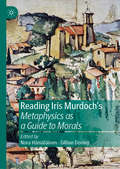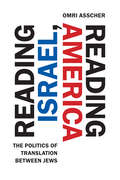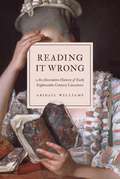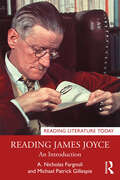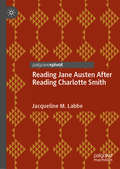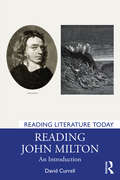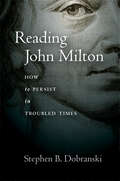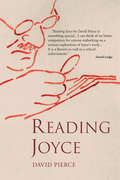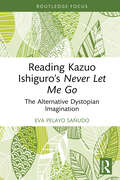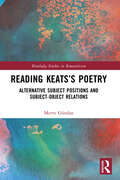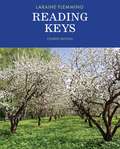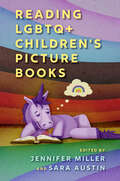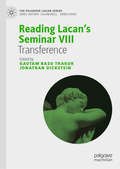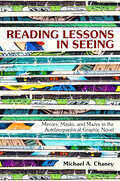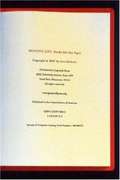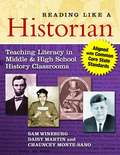- Table View
- List View
Reading Images for Knowledge Building: Analyzing Infographics in School Science (Routledge Studies in Multimodality)
by Len Unsworth J.R. MartinThis innovative volume provides a new analytic framework for understanding how meaning-making resources are deployed in images designed for knowledge building in school science.The framework enables analyses of science images from the perspectives of both their complexity and recognizability. Complexity deals with the technical and abstract knowledge of school science (technicality), evaluative dispositions in relation to that knowledge (iconization) and the condensation of the technical and dispositional meanings as ‘synoptic eyefuls’ in discipline-specific infographics (aggregation). Recognizability concerns the relationship between the appearance of phenomena in reality and the reconfiguration of this reality in images (congruence), the perceptibility or discernibility of the features and contexts of phenomena in images (explicitness), and how images engage their viewers (affiliation). The framework is illustrated by more than 100 images in colour in the e-book and black and white in the paper version and will inform research into multimodal literacy pedagogy that incorporates an understanding of the role of images in the teaching and learning of school science.This book will be of particular interest to scholars in multimodality, semiotics, literacy education and science education.
Reading Images: The Grammar of Visual Design
by Gunther Kress Theo van LeeuwenThis third edition of the landmark textbook Reading Images builds on its reputation as the first systematic and comprehensive account of the grammar of visual design. Drawing on an enormous range of examples from children's drawings to textbook illustrations, photo-journalism to fine art, as well as three-dimensional forms such as sculpture and toys, the authors examine the ways in which images communicate meaning. Features of this fully updated third edition include: new material on diagrams and data visualization a new approach to the theory of 'modality' a discussion of how images and their uses have changed since the first edition examples from a wide range of digital media including websites, social media, I-phone interfaces and computer games ideas on the future of visual communication. Reading Images presents a detailed outline of the 'grammar' of visual design and provides the reader with an invaluable 'tool-kit' for reading images in their contemporary multimodal settings. A must for students and scholars of communication, linguistics, design studies, media studies and the arts.
Reading India in a Transnational Era: The Works of Raja Rao
by Rumina Sethi; Letizia AlternoThis anthology demonstrates the significance of Raja Rao’s writing in the broader spectrum of anti-colonial, postcolonial and diasporic writing in the 20th Century. In addition to highlighting Rao’s significant presence in Indian writing, the volume presents a range of previously unpublished material which contextualises Rao’s work within 20th-century modernist, postmodernist and postcolonial trends. Exploring both his fictional and non-fictional works, Reading India in a Transnational Era engages with issues of subaltern agency and national belonging, authenticity, subjectivity, internationalism, multicultural politics, postcolonialism and literary and cultural representation through language and translation. A literary volume that discusses gender and identity on both socio-political grounds, apart from dealing with Rao’s linguistic experimentations in a transnational era, this book will be of interest among scholars and researchers of English, postcolonial and world literature, cultural theory and Asian studies.
Reading Inebriation in Early Colonial Peru (New Hispanisms: Cultural and Literary Studies)
by Mónica P. MoralesViewing a variety of narratives through the lens of inebriation imagery, this book explores how such imagery emerges in colonial Peru as articulator of notions of the self and difference, resulting in a new social hierarchy and exploitation. Reading Inebriation evaluates the discursive and geo-political relevance of representations of drinking and drunkenness in the crucial period for the consolidation of colonial power in the Viceroyalty of Peru, and the resisting rhetoric of a Hispanicized native Andean writer interested in changing stereotypes, fighting inequality, and promoting tolerance at imperial level in one of the main centers of Spanish colonial economic activity in the Americas. In recognizing and addressing this imagery, Mónica Morales restores an element of colonial discourse that hitherto has been overlooked in the critical readings dealing with the history of sixteenth and early seventeenth-century Andes. She presents drinking as the metaphorical site where Western culture and the New World collide and define themselves on the grounds of differing drinking rituals and ideas of moderation and excess. Narratives such as dictionaries, legal documents, conversion manuals, historical writings, literary accounts, and chronicles frame her context of analysis.
Reading Instruction 6 (Ready Common Core)
by Curriculum Associates*This textbook has been transcribed in UEB, formatted according to Braille textbook formats, proofread and corrected.
Reading Instruction That Works, Fourth Edition: The Case for Balanced Teaching
by Michael Pressley Richard L. AllingtonThis widely adopted text and K-8 practitioner resource demonstrates how successful literacy teachers combine explicit skills instruction with an emphasis on reading for meaning. Distinguished researcher Richard L. Allington builds on the late Michael Pressley's work to explain the theories and findings that guide balanced teaching and illustrate what exemplary lessons look like in action. Detailed examples offer a window into highly motivating classrooms around the country. Comprehensive in scope, the book discusses specific ways to build word recognition, fluency, vocabulary, and comprehension, especially for readers who are struggling. New to This Edition *Updated throughout to reflect important recent research advances. *Chapter summing up the past century's reading debates and the growing acceptance of balanced teaching. *New and revised vignettes of exemplary teachers.
Reading Instruction for Diverse Classrooms
by Nancy Hulan Ellen McintyreThis practical, teacher-friendly book provides indispensable guidance for implementing research-based reading instruction that is responsive to students' diverse cultural and linguistic backgrounds. Structured around the "big five" core topics of an effective reading program phonemic awareness, phonics, fluency, vocabulary, and comprehension the book explains tried-and-true teaching strategies for fostering all students' achievement. Key topics include engaging diverse students in classroom discussion, involving families in learning, and assessing and teaching new literacies. Numerous classroom examples demonstrate a wide range of easy-to-implement lesson ideas and activities for students at different grade levels, including struggling learners. Issues specific to English language learners are woven throughout the chapters.
Reading Iris Murdoch's Metaphysics as a Guide to Morals
by Nora Hämäläinen Gillian DooleyMetaphysics as a Guide to Morals was Iris Murdoch’s major philosophical testament and a highly original and ambitious attempt to talk about our time. Yet in the scholarship on her philosophical work thus far it has often been left in the shade of her earlier work. This volume brings together 16 scholars who offer accessible readings of chapters and themes in the book, connecting them to Murdoch’s larger oeuvre, as well as to central themes in 20th century and contemporary thought. The essays bring forth the strength, originality, and continuing relevance of Murdoch’s late thought, addressing, among other matters, her thinking about the Good, the role and nature of metaphysics in the contemporary world, the roles of art in human understanding, questions of unity and plurality in thinking, the possibilities of spiritual life without God, and questions of style and sensibility in intellectual work.
Reading Israel, Reading America: The Politics of Translation between Jews (Stanford Studies in Jewish History and Culture)
by Omri AsscherAmerican and Israeli Jews have historically clashed over the contours of Jewish identity, and their experience of modern Jewish life has been radically different. As Philip Roth put it, they are the "heirs jointly of a drastically bifurcated legacy." But what happens when the encounter between American and Israeli Jewishness takes place in literary form—when Jewish American novels make aliyah, or when Israeli novels are imported for consumption by the diaspora? Reading Israel, Reading America explores the politics of translation as it shapes the understandings and misunderstandings of Israeli literature in the United States and American Jewish literature in Israel. Engaging in close readings of translations of iconic novels by the likes of Philip Roth, Saul Bellow, Bernard Malamud, Amos Oz, A. B. Yehoshua, and Yoram Kaniuk—in particular, the ideologically motivated omissions and additions in the translations, and the works' reception by reviewers and public intellectuals—Asscher decodes the literary encounter between Israeli and American Jews. These discrepancies demarcate an ongoing cultural dialogue around representations of violence, ethics, Zionism, diaspora, and the boundaries between Jews and non-Jews. Navigating the disputes between these "rival siblings" of the Jewish world, Asscher provocatively untangles the cultural relations between Israeli and American Jews.
Reading It Wrong: An Alternative History of Early Eighteenth-Century Literature
by Abigail WilliamsHow eighteenth-century literature depended on misinterpretation—and how this still shapes the way we readReading It Wrong is a new history of eighteenth-century English literature that explores what has been everywhere evident but rarely talked about: the misunderstanding, muddle and confusion of readers of the past when they first met the uniquely elusive writings of the period. Abigail Williams uses the marginal marks and jottings of these readers to show that flawed interpretation has its own history—and its own important role to play—in understanding how, why and what we read.Focussing on the first half of the eighteenth century, the golden age of satire, Reading It Wrong tells how a combination of changing readerships and fantastically tricky literature created the perfect grounds for puzzlement and partial comprehension. Through the lens of a history of imperfect reading, we see that many of the period&’s major works—by writers including Daniel Defoe, Eliza Haywood, Mary Wortley Montagu, Alexander Pope and Jonathan Swift—both generated and depended upon widespread misreading. Being foxed by a satire, coded fiction or allegory was, like Wordle or the cryptic crossword, a form of entertainment, and perhaps a group sport. Rather than worrying that we don&’t have all the answers, we should instead recognize the cultural importance of not knowing.
Reading James Joyce: An Introduction (Reading Literature Today)
by Michael Patrick Gillespie A. Nicholas FargnoliReading James Joyce is a ready-at-hand compendium and all-encompassing interpretive guide designed for teachers and students approaching Joyce’s writings for the first time, guiding readers to better understand Joyce’s works and the background from which they emerged. Meticulously organized, this text situates readers within the world of Joyce including biographical exploration, discussion of Joyce’s innovations and prominent works such as Dubliners, Ulysses, and Finnegans Wake, surveys of significant critical approaches to Joyce’s writings, and examples of alternative readings and contemporary responses. Each chapter will provide interpretive approaches to contemporary literary theories and key issues, including end-of-chapter strategies and extended readings for further engagement. This book also includes shorter assessments of Joyce’s lesser-known works—critical writings, drama, poetry, letters, epiphanies, and personal recollections—to contextualize the creative and social environments from which his most notable publications arose. This uniquely comprehensive guide to Joyce will be an invaluable and comprehensive resource for readers exploring the influential world of Joyce studies.
Reading Jane Austen After Reading Charlotte Smith: Influences And Borrowings
by Jacqueline M. LabbeThis book explores what it means to read the six major works of Jane Austen, inlight of the ten major works of fiction by Charlotte Smith. It proposes that Smithhad a deep and lasting impact on Austen, but this is not an influence study. Instead,it argues for the possibility that two authors who never met could between themwrite something into being, both responding to and creating a novelistic zeitgeist.This, the book argues, can be called co-writing. This book will appeal to studentsand scholars of the novel, of women’s writing, and of Smith and Austen specifically.
Reading John Keats
by Susan J. WolfsonJohn Keats (1795–1821), one of the best-loved poets of the Romantic period, is ever alive to words, discovering his purposes as he reads - not only books but also the world around him. Leading Keats scholar Susan J. Wolfson explores the breadth of his works, including his longest ever poem Endymion; subsequent romances, Isabella (a Boccaccio tale with a proto-Marxian edge admired by George Bernard Shaw), the passionate Eve of St Agnes and knotty Lamia; intricate sonnets and innovative odes; the unfinished Hyperion project (Keats's existential rethinking of epic agony); and late lyrics involved with Fanny Brawne, the bright (sometimes dark) star of his last years. Illustrated with manuscript pages, title-pages, and two portraits, Reading John Keats investigates the brilliant complexities of Keats's imagination and his genius in wordplay, uncovering surprises and new delights, and encouraging renewed respect for the power of Keats's thinking and the subtle turns of his writing.
Reading John Milton: An Introduction (Reading Literature Today)
by David CurrellReading John Milton is a guide to Milton’s writings written for students, teachers, and readers everywhere seeking to approach this major figure in English and world literature. Milton’s works range from the monumental epic Paradise Lost to moving personal sonnets, from the tragic grandeur of Samson Agonistes to prose defenses of political liberty and religious tolerance. This book offers clear, fresh introductions and commentary that make an author with a reputation for difficulty relevant and accessible.Individual texts are placed in their literary and historical contexts, and explored so as to encourage fresh, independent interpretations informed by the contemporary humanities. Carefully organized for ease of use, the book opens with reasons why Milton matters, ideas for critical approaches, and a biography of Milton. Subsequent chapters are dedicated to groups of works or individual masterpieces. Key themes are placed in focus and a full overview provided for all of Milton’s major poems. Each chapter includes a set of stimulating questions and activities and suggestions for further reading keyed to a generous bibliography, including online resources.Reading John Milton is both an ideal introduction and a complete companion for anyone ready to experience the sublimity and delight of reading Milton.
Reading John Milton: How to Persist in Troubled Times
by Stephen DobranskiA captivating biography that celebrates the audacious, inspiring life and works of John Milton, revealing how he speaks to our times. John Milton is unrivalled—for the music of his verse and the breadth of his learning. In this brisk, topical, and engaging biography, Stephen B. Dobranski brushes the scholarly dust from the portrait of the artist to reveal Milton's essential humanity and his unwavering commitment to ideals—freedom of religion and the right and responsibility of all persons to think for themselves—that are still relevant and necessary in our times. Milton's epic poem, Paradise Lost, is considered by many to be English poetry's masterpiece. Samuel Johnson, not one for effusive praise, claimed that from Milton's "books alone the Art of English Poetry might be learned." But Milton's renown rests on more than his artistic achievements. In a time of convulsive political turmoil, he justified the killing of a king, pioneered free speech, and publicly defended divorce. He was, in short, an iconoclast, an independent, even revolutionary, thinker. He was also an imperfect man—acrimonious, sometimes mean. Above all, he understood adversity. Afflicted by blindness, illness, and political imprisonment, Milton always sought to "bear up and steer right onward" through life's hardships. Dobranski looks beyond Milton's academic standing, beyond his reputation as a dour and devout purist, to reveal the ongoing power of his works and the dauntless courage that he both wrote about and exemplified.
Reading Joyce (Reading Literature)
by David Pierce`Is there one who understands me?' So wrote James Joyce towards the end of his final work, Finnegans Wake. The question continues to be asked about the author who claimed that he had put so many enigmas into Ulysses that it would `keep the professors busy for centuries' arguing over what he meant. For Joyce this was a way of ensuring his immortality, but it could also be claimed that the professors have served to distance Joyce from his audience, turning his writings into museum pieces, pored over and admired, but rarely touched. In this remarkable book, steeped in the learning gained from a lifetime's reading, David Pierce blends word, life and image to bring the works of one of the great modern writers within the reach of every reader. With a sharp eye for detail and an evident delight in the cadences of Joyce's work, Pierce proves a perfect companion, always careful and courteous, pausing to point out what might otherwise be missed. Like the best of critics, his suggestive readings constantly encourage the reader back to Joyce's own words. Beginning with Dubliners and closing with Finnegans Wake, Reading Joyce is full of insights that are original and illuminating, and Pierce succeeds in presenting Joyce as an author both more straightforward and infinitely more complex than we had perhaps imagined. T. S. Eliot wrote of Joyce's masterpiece, Ulysses, that it is `a book to which we are all indebted, and from which none of us can escape'. With David Pierce as a guide, the debt we owe to Joyce becomes clearer, and the need to flee is greatly reduced.
Reading Kazuo Ishiguro’s Never Let Me Go: The Alternative Dystopian Imagination (Routledge Focus on Literature)
by Eva Pelayo SañudoReading Kazuo Ishiguro’s Never Let Me Go: The Alternative Dystopian Imagination aims to offer innovative perspectives for the analysis of Nobel-prize winner Kazuo Ishiguro’s oeuvre through a focus on the genre of science fiction, particularly the novel Never Let Me Go (2005). The study proposes the term "intimate dystopia" to reflect on the passage from totalitarian or external oppressive forces to more "subtle" systems of power. Its interdisciplinary approach combines, apart from literary theory on different genres such as science fiction and memory, race studies, feminism and ecocriticism. It is based on an exhaustive critical and textual analysis that allows for a thorough and nuanced understanding of Ishiguro’s multi-layered novel, covering themes such as the ethical dimensions and gender implications of caregiving, the dystopian portrayal of the environment, the significance of art in the existence of marginalized groups and the genre-related complexities of the text.
Reading Keats’s Poetry: Alternative Subject Positions and Subject-Object Relations (Routledge Studies in Romanticism)
by Merve GündayThis book claims that Keats’s poetry is a reaction against the discourse of modernity which traumatized the human subject by creating a divide between human and nature, subject and object. It argues that by transcending this divide and acknowledging the agency of both subject and object, Keats makes an ideological statement and offers a new site of existence or relationality to readers. This site also implies a response to the accusations that the Romantics were not interested in the realities of their time. What Keats does is to give an aestheticized response to the hardcore facts of his time. Departing from previous studies due to its emphasis on subjectivity and relationality, the book discusses Keats with regard to post/non-anthropocentric, alternative subject positions and subject-object relations in his “Ode to a Nightingale,” “In drear nighted December,” “Isabella; or, The Pot of Basil,” “Lamia,” “La Belle Dame sans Mercy,” and “Ode on a Grecian Urn.” Drawing on Lacanian and Braidottian epistemologies in its discussion of the intricacy between the imaginary and the symbolic, the irruption of the psychotic into the symbolic, and the agency of the object on the subject in Keats’s poetry, the book suggests that the inner dynamics of both the subject and the object acquire agency, which shatters Oneness and totality assumed in the Cartesian self.
Reading Keys (Fourth Edition)
by Laraine E. FlemmingREADING KEYS - the first in a three-book reading series by Laraine Flemming - offers a comprehensive introduction to reading skills and strategies, from using context clues to identifying purpose and bias. Clear, accessible explanations present reading concepts without oversimplifying the process of reading comprehension. To ensure students' understanding, reading "keys" or summaries follow the explanations, breaking them down into manageable chunks. Throughout each chapter, a variety of steadily more difficult exercises assess students' understanding of the material and promote improved comprehension and critical-thinking skills. This incremental approach to instruction and assessment makes it easier for beginning readers to absorb and master new information. The Fourth Edition includes new chapters on analyzing arguments and sentence relationships. In addition, there is a greater emphasis on recognizing and understanding verbal clues to meaning, new discussions on how the brain learns and remembers new information, and several new engaging readings.
Reading LGBTQ+ Children's Picture Books (Children's Literature Association Series)
by Jennifer Miller and Sara AustinContributions by Sara Austin, Rob Bittner, J. Bradley Blankenship, Gabriel Duckels, Caitlin Howlett, Isabel Millán, Jennifer Miller, Kaylee Jangula Mootz, Tim Morris, Dana Rudolph, j wallace skelton, Jason Vanfosson, River Vooris, and B. J. WoodsteinPicture books are books aimed at children where the illustrations are as important, or more important, than the text. Picture books, the effects of their simple text and importance in the literary canon, have been studied by scholars for decades, but little attention has been given to LGBTQ+ picture books. Reading LGBTQ+ Children’s Picture Books is a collection of essays that identifies and interprets children’s picture books that explicitly represent LGBTQ+ content.Contributors to the volume include established and emerging scholars with expertise in the fields of children’s literature, young adult literature, cultural studies, critical race and ethnic studies, gender and sexuality studies, history, and education. Each essay introduces readers to several children’s books that denote unmistakable LGBTQ+ content. Essays bring various interpretive frameworks and intellectual commitments to their unique readings of LGBTQ+ children’s picture books. The essays in Reading LGBTQ+ Children’s Picture Books produce innovative new scholarship about a range of topics including representations of LGBTQ+ marriage and parenting and LGBTQ+ history and culture. The topics explored, and theoretical frameworks applied, significantly expand available and accessible up-to-date scholarship on the growing field of LGBTQ+ children’s picture books.
Reading Lacan’s Seminar VIII: Transference (The Palgrave Lacan Series)
by Gautam Basu Thakur Jonathan DicksteinThis book provides 18 lively commentaries on Lacan’s Seminar VIII, Transference (1960-61) that explore its theoretical and philosophical consequences in the clinic, the classroom, and society. Including contributions from clinicians as well as scholars working in philosophy, literature, and culture studies, the commentaries presented here represent a wide-range of disciplinary perspectives on the concept of transference. Some chapters closely follow the structure of the seminar’s sessions, while others take up thematic concerns or related sessions such as the commentary on sessions 19 to 22 which deal with Lacan’s discussion of Claudel’s Coûfontaine trilogy. This book is not a compendium to Lacan’s seminar. Instead it attempts to capture through shorter contributions a spectrum of voices debating, deliberating, and learning with Lacan’s concept. In doing so it can be seen to engage with transference conceptually in a manner that matches the spirit of Lacan’s seminar itself.The book will provide an invaluable new resource for Lacan scholars working across the fields of psychoanalytic theory, clinical psychology, philosophy and cultural studies.
Reading Lessons in Seeing: Mirrors, Masks, and Mazes in the Autobiographical Graphic Novel
by Michael A. ChaneyLiterary scholar Michael A. Chaney examines graphic novels to illustrate that in form and function they inform readers on how they ought to be read. His arguments result in an innovative analysis of the various knowledges that comics produce and the methods artists and writers employ to convey them. Theoretically eclectic, this study attends to the lessons taught by both the form and content of today's most celebrated graphic novels.Chaney analyzes the embedded lessons in comics and graphic novels through the form's central tropes: the iconic child storyteller and the inherent childishness of comics in American culture; the use of mirrors and masks as ciphers of the unconscious; embedded puzzles and games in otherwise story-driven comic narratives; and the form's self-reflexive propensity for showing its work. Comics reveal the labor that goes into producing them, embedding lessons on how to read the "work" as a whole.Throughout, Chaney draws from a range of theoretical insights from psychoanalysis and semiotics to theories of reception and production from film studies, art history, and media studies. Some of the major texts examined include Marjane Satrapi's Persepolis; Chris Ware's Jimmy Corrigan: The Smartest Kid on Earth; Joe Sacco's Palestine; David B.'s Epileptic; Kyle Baker's Nat Turner; and many more. As Chaney's examples show, graphic novels teach us even as they create meaning in their infinite relay between words and pictures.
Reading Life: Books for the Ages
by Sven BirkertsA new, compelling collection of essays by Sven Birkerts, "one of America's most distinguished, eloquent servants of the poetry and fiction that matter" (Susan Sontag). Reading, the mind's traffic in signs and signifiers, is the most dynamic, changeful, and possibly transformational act we can imagine. To have read a work and have been strongly affected by it--and then to come back to it after many years--can be a foundation-shaking enterprise. In Reading Life, virtuoso critic and essayist Sven Birkerts examines what it means to return to resonant works of fiction--the books one thinks of "covetously, as private properties," the "personal signposts" of one's inner life. For Birkerts, these include The Catcher in the Rye, Humboldt's Gift, To the Lighthouse, and Lolita. In twelve far-reaching and intimate essays, Birkerts reflects upon his first readings and what later encounters reveal about time, memory, and the murmuring transistors of selfhood.
Reading Like A Historian: Teaching Literacy In Middle And High School History Classrooms
by Sam Wineburg Daisy Martin Chauncey Monte-SanoFeaturing an expanded introduction, this award-winning bestseller has been updated to link curriculum to the Common Core State Standards. This popular text shows how to apply Wineburg’s highly acclaimed approach to teaching― Reading Like a Historian―to middle and high school classrooms, increasing academic literacy and sparking students’ curiosity. Each chapter begins with an introductory essay that sets the stage of a key moment in American history―beginning with exploration and colonization and the events at Jamestown and ending with the Cuban Missile Crisis. Primary documents, charts, graphic organizers, visual images, and political cartoons follow each essay, as well as suggestions for where to find additional resources on the Internet and guidance for assessing students’ understanding of core historical ideas. Reading Like a Historian helps teachers use textbooks creatively and provides a wealth of ideas for how historical instruction can enhance students’ skills in reading comprehension.
